The Intel 9th Gen Review: Core i9-9900K, Core i7-9700K and Core i5-9600K Tested
by Ian Cutress on October 19, 2018 9:00 AM EST- Posted in
- CPUs
- Intel
- Coffee Lake
- 14++
- Core 9th Gen
- Core-S
- i9-9900K
- i7-9700K
- i5-9600K
CPU Performance: Web and Legacy Tests
While more the focus of low-end and small form factor systems, web-based benchmarks are notoriously difficult to standardize. Modern web browsers are frequently updated, with no recourse to disable those updates, and as such there is difficulty in keeping a common platform. The fast paced nature of browser development means that version numbers (and performance) can change from week to week. Despite this, web tests are often a good measure of user experience: a lot of what most office work is today revolves around web applications, particularly email and office apps, but also interfaces and development environments. Our web tests include some of the industry standard tests, as well as a few popular but older tests.
We have also included our legacy benchmarks in this section, representing a stack of older code for popular benchmarks.
All of our benchmark results can also be found in our benchmark engine, Bench.
WebXPRT 3: Modern Real-World Web Tasks, including AI
The company behind the XPRT test suites, Principled Technologies, has recently released the latest web-test, and rather than attach a year to the name have just called it ‘3’. This latest test (as we started the suite) has built upon and developed the ethos of previous tests: user interaction, office compute, graph generation, list sorting, HTML5, image manipulation, and even goes as far as some AI testing.
For our benchmark, we run the standard test which goes through the benchmark list seven times and provides a final result. We run this standard test four times, and take an average.
Users can access the WebXPRT test at http://principledtechnologies.com/benchmarkxprt/webxprt/
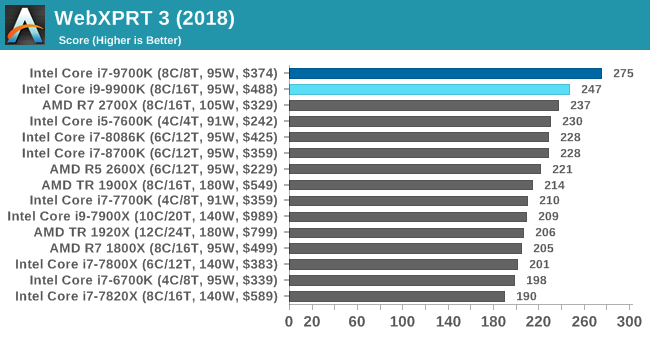
WebXPRT 2015: HTML5 and Javascript Web UX Testing
The older version of WebXPRT is the 2015 edition, which focuses on a slightly different set of web technologies and frameworks that are in use today. This is still a relevant test, especially for users interacting with not-the-latest web applications in the market, of which there are a lot. Web framework development is often very quick but with high turnover, meaning that frameworks are quickly developed, built-upon, used, and then developers move on to the next, and adjusting an application to a new framework is a difficult arduous task, especially with rapid development cycles. This leaves a lot of applications as ‘fixed-in-time’, and relevant to user experience for many years.
Similar to WebXPRT3, the main benchmark is a sectional run repeated seven times, with a final score. We repeat the whole thing four times, and average those final scores.

Speedometer 2: JavaScript Frameworks
Our newest web test is Speedometer 2, which is a accrued test over a series of javascript frameworks to do three simple things: built a list, enable each item in the list, and remove the list. All the frameworks implement the same visual cues, but obviously apply them from different coding angles.
Our test goes through the list of frameworks, and produces a final score indicative of ‘rpm’, one of the benchmarks internal metrics. We report this final score.
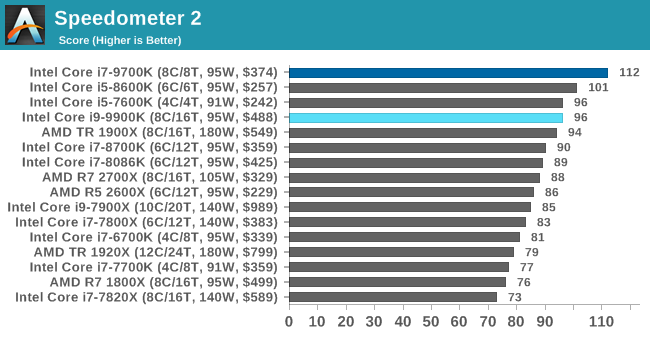
Google Octane 2.0: Core Web Compute
A popular web test for several years, but now no longer being updated, is Octane, developed by Google. Version 2.0 of the test performs the best part of two-dozen compute related tasks, such as regular expressions, cryptography, ray tracing, emulation, and Navier-Stokes physics calculations.
The test gives each sub-test a score and produces a geometric mean of the set as a final result. We run the full benchmark four times, and average the final results.
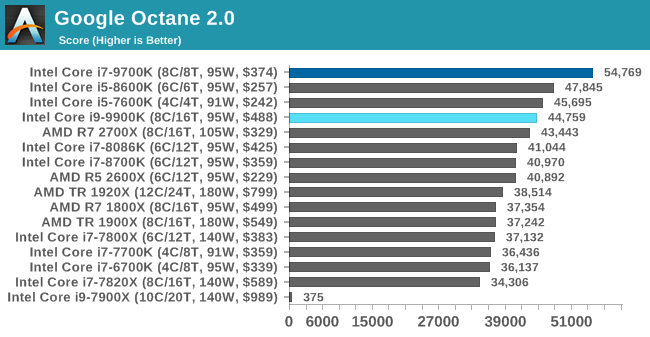
Mozilla Kraken 1.1: Core Web Compute
Even older than Octane is Kraken, this time developed by Mozilla. This is an older test that does similar computational mechanics, such as audio processing or image filtering. Kraken seems to produce a highly variable result depending on the browser version, as it is a test that is keenly optimized for.
The main benchmark runs through each of the sub-tests ten times and produces an average time to completion for each loop, given in milliseconds. We run the full benchmark four times and take an average of the time taken.
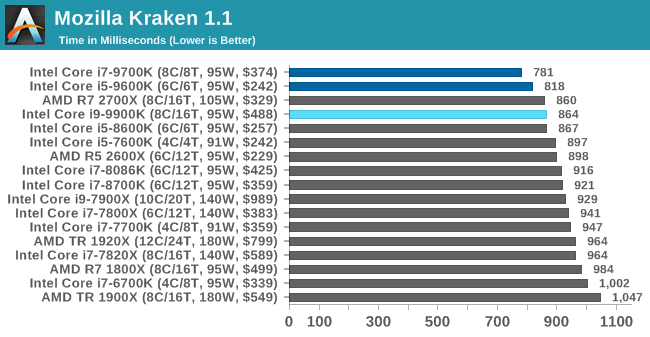
3DPM v1: Naïve Code Variant of 3DPM v2.1
The first legacy test in the suite is the first version of our 3DPM benchmark. This is the ultimate naïve version of the code, as if it was written by scientist with no knowledge of how computer hardware, compilers, or optimization works (which in fact, it was at the start). This represents a large body of scientific simulation out in the wild, where getting the answer is more important than it being fast (getting a result in 4 days is acceptable if it’s correct, rather than sending someone away for a year to learn to code and getting the result in 5 minutes).
In this version, the only real optimization was in the compiler flags (-O2, -fp:fast), compiling it in release mode, and enabling OpenMP in the main compute loops. The loops were not configured for function size, and one of the key slowdowns is false sharing in the cache. It also has long dependency chains based on the random number generation, which leads to relatively poor performance on specific compute microarchitectures.
3DPM v1 can be downloaded with our 3DPM v2 code here: 3DPMv2.1.rar (13.0 MB)
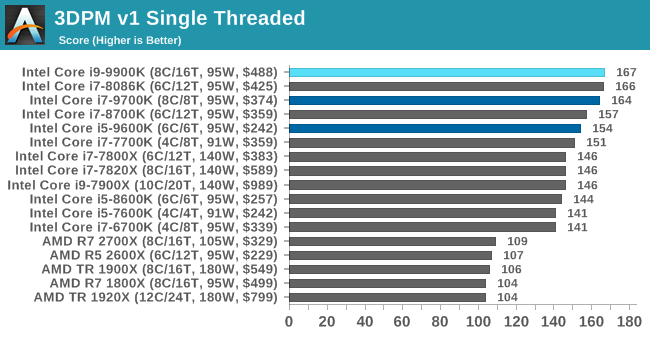
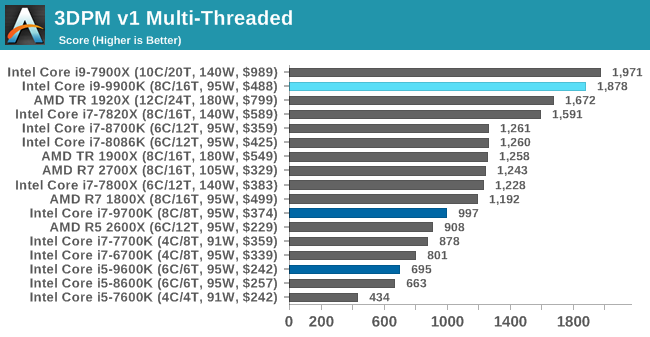
x264 HD 3.0: Older Transcode Test
This transcoding test is super old, and was used by Anand back in the day of Pentium 4 and Athlon II processors. Here a standardized 720p video is transcoded with a two-pass conversion, with the benchmark showing the frames-per-second of each pass. This benchmark is single-threaded, and between some micro-architectures we seem to actually hit an instructions-per-clock wall.
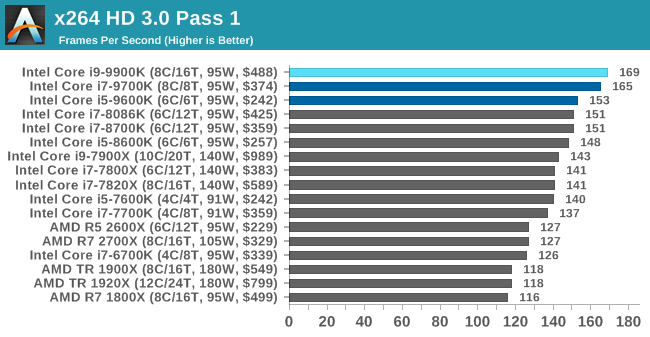
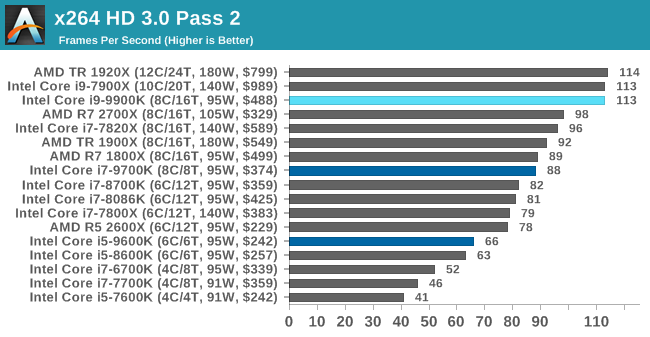










274 Comments
View All Comments
0ldman79 - Friday, October 19, 2018 - link
AMD needs to improve their AVX processing as well, but they've got Intel in a bit of a predicament.Hifihedgehog - Friday, October 19, 2018 - link
Ladies and gentlemen, I present to you...Intel’s FX 9000 series.
Now even hotter and more power hungry than ever!
mapesdhs - Sunday, October 21, 2018 - link
It reminds me a lot of the P4 days when Intel just had to shove clocks through the roof to remain relevant. And I don't know why tech sites are salivating so much on oc levels that are barely any better than a chip's max turbo, it's a far cry from the days of SB, especially since one can run a 2700K at 5GHz with sensible voltage and good temps using a simple air cooler (ordinary TRUE works fine) and one fan, without high noise (I know, I've built seven of them so far). To me, the oc'ing potential of the 9K series is just boring, especially since the cost is so high that for gaming one is far better off buying a 2700X, 8700K (or many other options) and using the save to get a better GPU.sgeocla - Friday, October 19, 2018 - link
Why compare to the TR 1920x ($799) and not to the TR 2950X ($899)?The TR 2950X kills it in almost every productivity benchmark even against i-9 9900k.
Not even mentioning the 9th gen power consumption.
Yorgos - Friday, October 19, 2018 - link
don't bother with the review.They show you the results that makes intel seem good.
Intel/Purch media have failed to show to the people that they exceed even Threadripper's TDP in order to fight Zen.
Desperate moves for desperate times.
Better look somewhere else for an unbiased review.
mkaibear - Friday, October 19, 2018 - link
What, you mean apart from page 21 where it shows that it almost doubles Threadripper's TDP for the same core count CPU and is 50% greater than the one which has 50% more cores than it does?Some reading comprehension lessons needed I think.
yeeeeman - Friday, October 19, 2018 - link
The 9900K looks like a nice CPU, but damn that power consumption is stupidly high. It is almost twice what the 2700X consumes.Hifihedgehog - Friday, October 19, 2018 - link
*High-end AIO required.AGS3 - Friday, October 19, 2018 - link
Twice the CPU - 8 cores over 5Ghz :)AutomaticTaco - Saturday, October 20, 2018 - link
Revised down. The first motherboard they used was extremely higher voltage settings.https://www.anandtech.com/show/13400/intel-9th-gen...